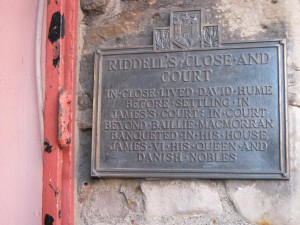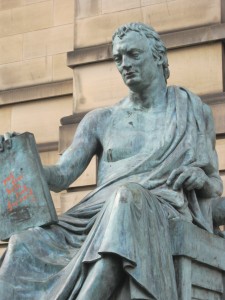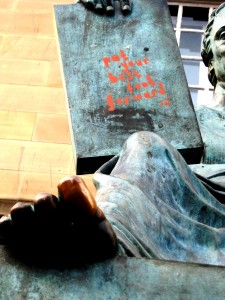As its name implies, the activity I’m calling “philosophical geocaching” usually consists of hours and hours of way-finding, using a map that displays a complete disregard for the point of your interest, and is concluded when the way-finder arrives at the landmark in question, only to find that it isn’t quite the landmark they were promised, or that the landmark was taken away last week/month/year/who knows when,[1] or that the landmark is there but, well, it isn’t very dramatic or interesting.For these and oh so many other reasons, philocaching is thus a tourist activity I can heartily recommend only to those of you traveling with other philosophers, or those of you accompanied by incredibly good-natured, incredibly pliant, or incredibly bribe-able travel companions.
I don’t mean to brag, but I’ve philocached in Harvard, Massachusetts, Burlington, Vermont (oh, yeah, that was a classic case of cachus disappointus!), Connemara, Ireland, Rome, and of course Amsterdam, to name just some of the choicer locales. And I have never found a city, town or municipality that went out of its way to associate itself with any of the philosophers who happened to live in its midst. Translation: only the persistent will uncover any evidence that Thoreau/Dewey/Wittgenstein/Queen Christina/Descartes was here.
And then I went to Edinburgh. Edinburgh–that beautiful, fairytale city–positively celebrates David Hume, its most important philosopher. (It’s pretty high on Adam Smith, its most important philosopher-turned-political-economist, too.) The city is veritably awash in Humeana.
First, there’s Allan Ramsay’s famous painting of Hume, which normally hangs in the National Portrait Gallery, but which right now is hanging in the National Gallery, because the Portrait Gallery is closed. It’s on exhibit in a special show called “Portrait of the Nation.” Yes, that’s right, not only is Hume’s portrait too important to be stored away for the entirety of the renovation process, but it’s so important to Scotland—that is, Hume is so important to Scotland—that they put it into a special show! (Right at the beginning of the show, I might add, so even the people who get bored and leave before looking at every painting will see it.)
There’s a plaque (small and discrete, but located on the Royal Mile, the most heavily touristed street in the city), commemorating the “close” (i.e. dead end street) in which Hume lived. Yes! The city of Edinburgh actually cares where Hume lived!
Even the canned tour bus commentary points out the Hume tourist attractions! (Erroneously, I thought at the time, but that’s okay, because it made me feel like a real geocacher after all. Watch for the story of David Hume, Nature Boy, in an upcoming geocaching post.)
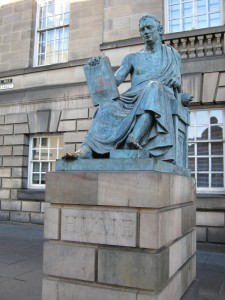 But the most famous (and most visible) Hume tourist destination is undoubtedly his statue. In Edinburgh, the sculpture celebrating Mr. Missing Shade is plunked down, right there, on the Royal Mile (right across from St. Giles Cathedral and that place where you’re supposed to spit). You can’t miss him. And if you do, any number of people, guidebooks and tour buses will be perfectly happy to tell you where to find it.
But the most famous (and most visible) Hume tourist destination is undoubtedly his statue. In Edinburgh, the sculpture celebrating Mr. Missing Shade is plunked down, right there, on the Royal Mile (right across from St. Giles Cathedral and that place where you’re supposed to spit). You can’t miss him. And if you do, any number of people, guidebooks and tour buses will be perfectly happy to tell you where to find it.
About that statue: not everyone finds its prominence something to celebrate. On one tourism website, C. Navarro of Alexandria, Virginia, had this to say: “The statue is a laughable monstrosity. The bare-footed, half-naked, andropausal, degenerate-looking figure depicted bears not the slightest resemblance to the great philosopher. Its sculptor, Sandy Stoddard, the Duke of Edinburgh who approved it, and Nigel Bruce, Convenor of the Saltire Society that commissioned it, obviously had never read David Hume. I suggest that the thing be removed, melted, and the bronze recycled for fancy ashtrays or some other commerical product.”
Really? I quite liked it! ‘Course I was so thunderstruck at the ease with which I found it (and a little star struck as well—it’s not every day you come face-to-toe with a famous philosopher) that it didn’t occur to me not to like the statue.
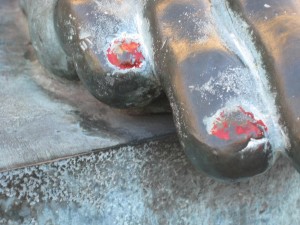 Turns out there’s even a real-live college student tradition associated with it! A philosophy student tradition! For more on that, let’s turn to a website called “Frost’s Scottish Anatomy.” There we read of a young student at the University of Edinburgh, who reports that, “A friend of mine told me there is this statue on the Royal Mile that you touch the feet of for knowledge. So I did it before my philosophy exam,” said Chris Corry, 19, a second-year philosophy student at Edinburgh University, who managed to pass last term. “I didn’t work very hard, so it was probably luck. … Maybe (touching Hume’s toe) had something to do with it.” The writer of the article believes that Hume would have been dismayed by the superstition evidenced in the practice. Maybe; I tend to think that the Hume who was eager for some public recognition would have preened at the thought that eager young students were coming to rub his toe.
Turns out there’s even a real-live college student tradition associated with it! A philosophy student tradition! For more on that, let’s turn to a website called “Frost’s Scottish Anatomy.” There we read of a young student at the University of Edinburgh, who reports that, “A friend of mine told me there is this statue on the Royal Mile that you touch the feet of for knowledge. So I did it before my philosophy exam,” said Chris Corry, 19, a second-year philosophy student at Edinburgh University, who managed to pass last term. “I didn’t work very hard, so it was probably luck. … Maybe (touching Hume’s toe) had something to do with it.” The writer of the article believes that Hume would have been dismayed by the superstition evidenced in the practice. Maybe; I tend to think that the Hume who was eager for some public recognition would have preened at the thought that eager young students were coming to rub his toe.
About that red toenail polish in the photo above, one commentator on another tourist site observed, “The David Hume statue is also, I believe, the most abused statue in Edinburgh. Which is, in one way, fair enough. But I don’t think people are putting traffic cones on his head because he was racist, or because they disagree with his theory of causality. Maybe he’s just a lot more accessible than the other statues.”
[1] Such was the sad case of the highway sign that allegedly marked the spot of W.E.B. Du Bois’s childhood home in Great Barrington, Massachusetts. After, oh, an hour of ramming around in the brushy undergrowth, four Phil on HOl veterans—moi, Peg, Barb the Brief and Jay the Web Guy—failed utterly to find even the tattered remains of a former highway sign.

